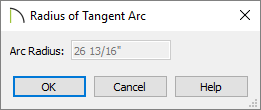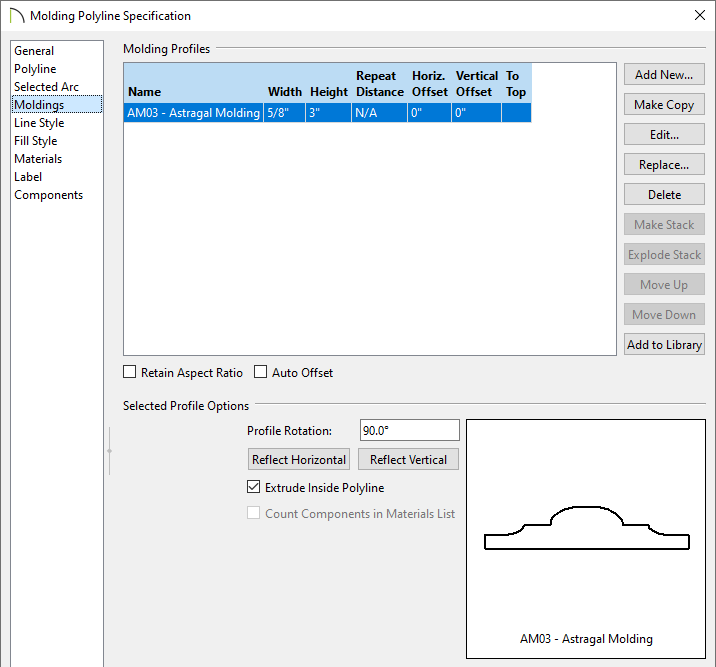The information in this article applies to:

QUESTION
What are molding polylines and how can they be used?
ANSWER
A molding polyline is a path that either a 2D molding profile is extruded along or a series of symbol moldings is repeated along. Molding polylines can be used to add decorative detail anywhere in your 3D model.
In X15 and prior versions, separate 2D and 3D Molding Polyline tools were available. These tools have since been combined into a single tool starting with X16.
It's important to note that in X15 and prior versions, a 2D molding polyline must be drawn in plan view, while 3D molding polylines can be drawn in elevation or section views, and create vertical moldings. 3D molding polylines also do not have to be coplanar, meaning that a given edge can go in any direction in all three dimensions.
In this article, an oblong mirror will be created, and a custom frame will be generated using a molding polyline.
To create the mirror
- Navigate to 3D> Create Orthographic View> Cross Section/Elevation
 from the menu, then click and drag towards the wall that will have the mirror.
from the menu, then click and drag towards the wall that will have the mirror.
- Select Build> 3D Solid/Primitive> 3D Solid
 , then click and drag to create a rectangular 3D/polyline solid.
, then click and drag to create a rectangular 3D/polyline solid.
In this example the 3D/polyline solid is 2' (ft) x 4' (ft) in size.

- Using the Select Objects
 tool, click on the 3D/polyline solid to select it, then click the Open Object
tool, click on the 3D/polyline solid to select it, then click the Open Object  edit tool.
edit tool.
- In the 3D Solid Specification dialog that displays next:

- On the 3D or General panel, set the Depth/Thickness
In this example, a value of 1/4" is specified.
- On the Materials panel, select the 3D/Polyline Solid component and click the Select Material button. Browse to or search for your desired material, then click OK.
In this example a "Mirror" material is used.
- Click OK again to close the dialog and confirm the changes.
- With the 3D/polyline solid still selected, click on the upper edge to make this the active edge.
The edge of a polyline-based object that has the largest edit handle and is typically a different color is the active side. All other sides will have smaller edit handles with a different color.
- Select the Change Line/Arc
 edit tool to convert the upper edge to an arc.
edit tool to convert the upper edge to an arc.
- Click the Make Arc Tangent
 edit tool. In the Radius of Tangent Arc dialog that appears, click OK.
edit tool. In the Radius of Tangent Arc dialog that appears, click OK.

- Repeat steps 6-7 for the lower edge

To create the frame using a molding polyline
- Using the Select Objects
 tool, select the 3D/polyline solid, then navigate to Edit> Copy and Paste in Place
tool, select the 3D/polyline solid, then navigate to Edit> Copy and Paste in Place  .
.
- With the new, copied 3D/polyline solid selected, click the Convert Polyline
 edit tool.
edit tool.
In X15 and prior versions, select the Convert to Plain Polyline  edit tool, then click the Convert Polyline
edit tool, then click the Convert Polyline  edit tool.
edit tool.
- In the Convert Polyline dialog that displays, choose the Molding Polyline option and click OK.
In X15 and prior versions, select the 3D Molding Polyline option instead.

- In the Molding Polyline Specification or 3D Molding Polyline Specification dialog that opens next, click on the Moldings panel.

- Notice that a square molding profile is already chosen. Click Replace and browse to a more appropriate molding.
In this example, the AM03 - Astragal Molding profile is used. In prior versions, this may have been named CA-24.
- Set the Width and Height of the molding to be the thickness and depth of the frame desired for the mirror.
In this example, the Width is set to 5/8" and the Height is set to 3".
- Specify any other properties such as the Profile Rotation.
In this example, this is set to 90°, though this may not be needed in X15 and prior versions.
- Select the Materials panel to choose an appropriate material for the molding profile, then click OK to close the dialog.
-
Take a
Camera 
view to see the results.

Consider blocking the 3D/polyline solid and the molding polyline together so the mirror is treated as a single entity. To learn more, please see the "Creating an Architectural Block" resource in the Related Articles section below.







